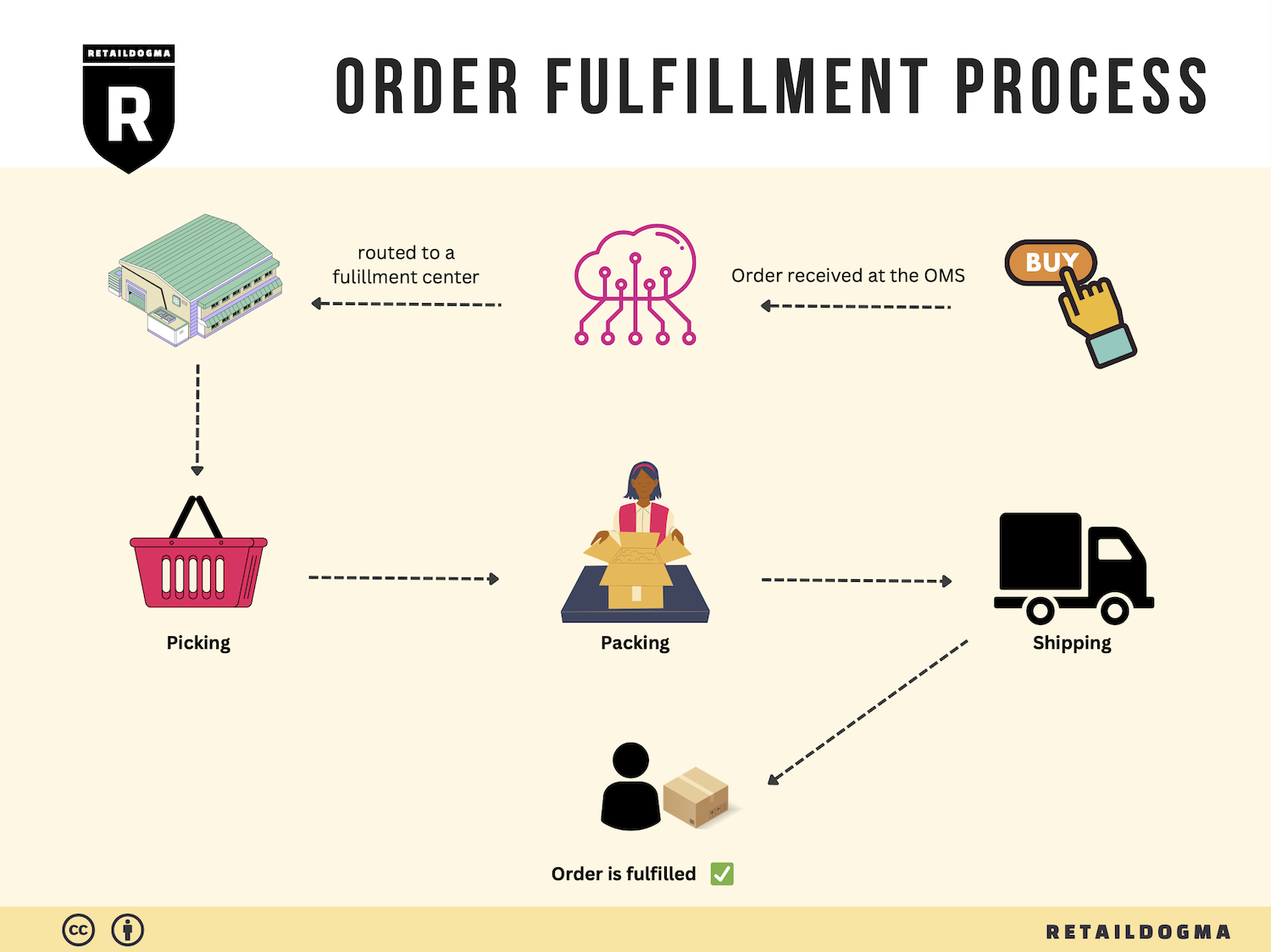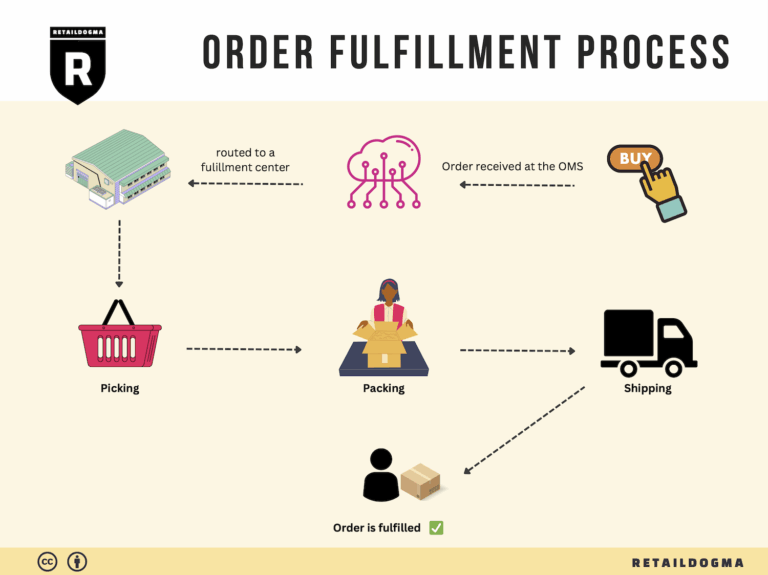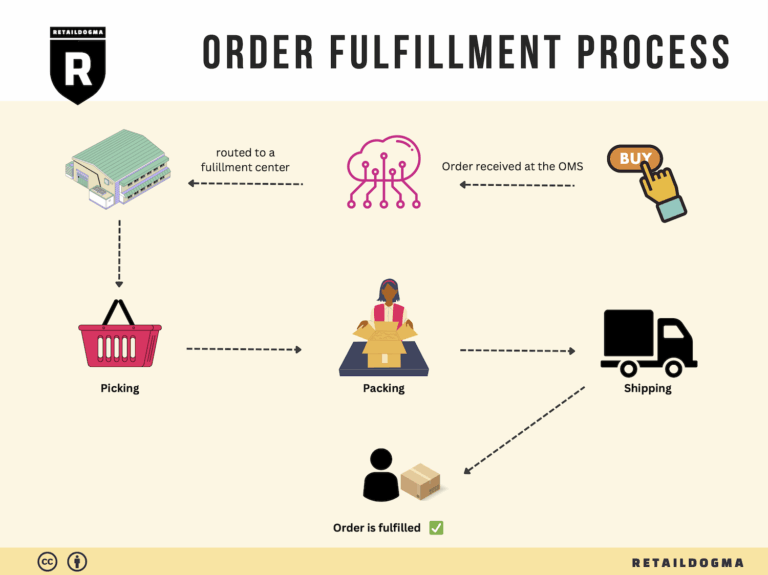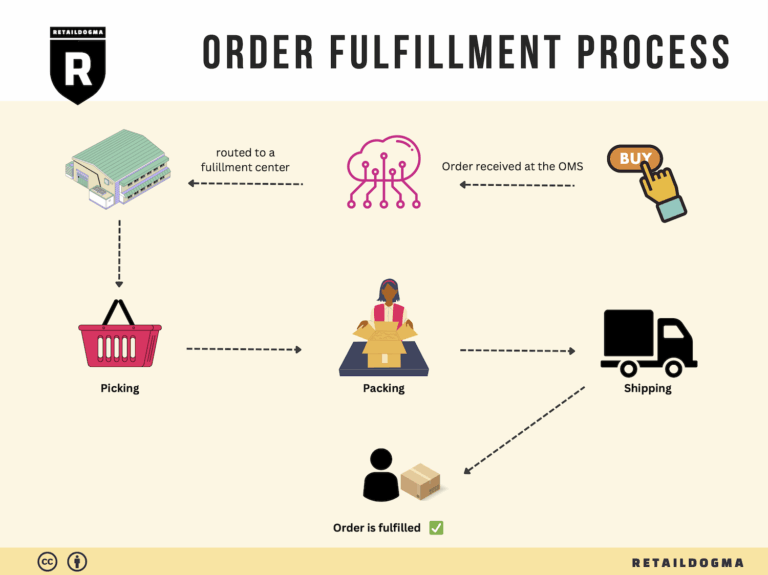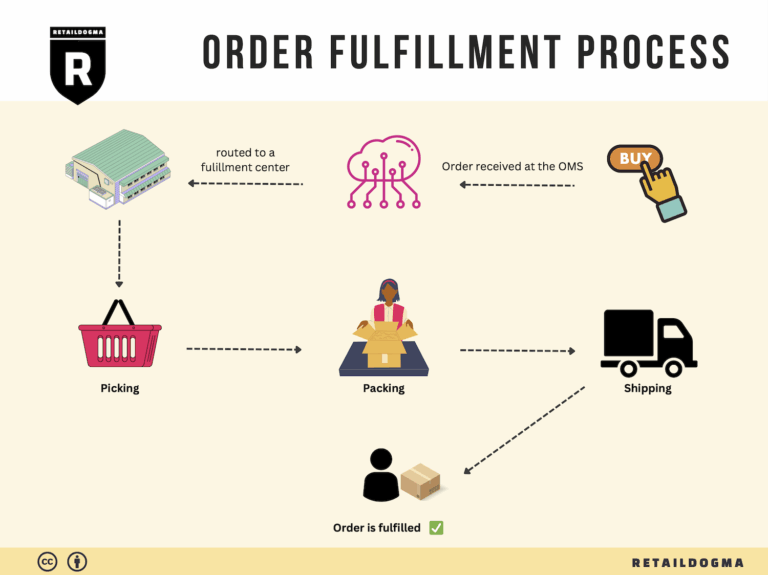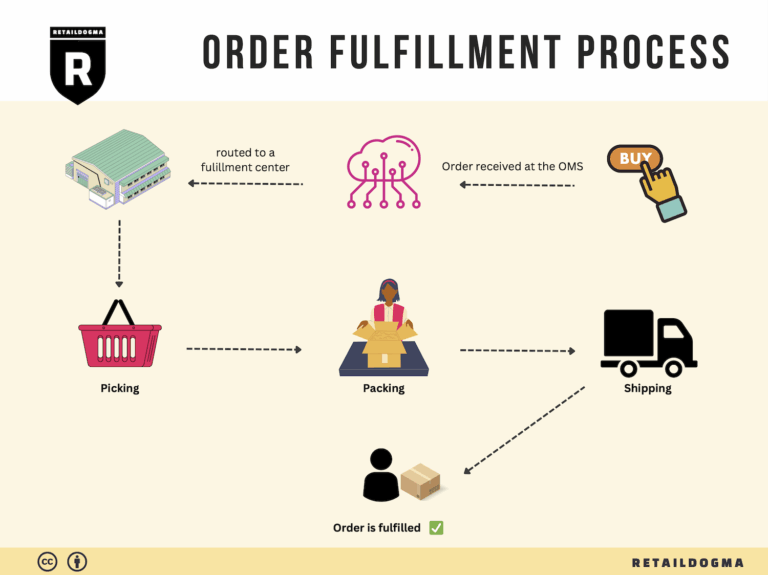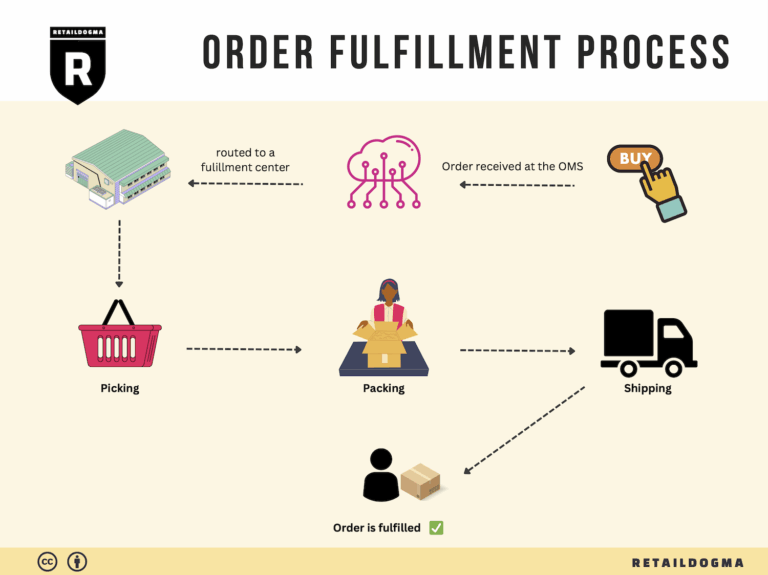What Is A Fulfillment Center? A Complete Guide (2025)
What is E-commerce Fulfillment? An Introduction for Growing Businesses
As your e-commerce business begins to flourish, you may find yourself grappling with the increasingly complex demands of packing and shipping orders. The excitement of growing sales can quickly turn into a logistical nightmare, leaving you overwhelmed and distracted from your core business objectives. This is where understanding e-commerce fulfillment becomes essential. Simply put, fulfillment is the process of getting a product from your warehouse to your customer’s doorstep.
Navigating the fulfillment landscape can be daunting, especially for those looking to scale their operations. In this guide, we will demystify e-commerce fulfillment, providing you with insights into various fulfillment models that can support your growth. From Third-Party Logistics (3PL) providers to Fulfilled by Amazon (FBA), we’ll explore the pros and cons of each approach, helping you determine which model aligns best with your business needs.
Core Services of E-commerce Fulfillment
We will delve into the core services that comprise effective fulfillment operations, including warehousing, inventory management, order processing, pick and pack services, and shipping logistics. These components are crucial for ensuring that orders are processed efficiently and accurately, which ultimately impacts customer satisfaction and retention.
Choosing the Right Fulfillment Partner
Selecting the right fulfillment partner can be a game-changer for your business. We will guide you through the key factors to consider when evaluating potential partners, such as their technology capabilities, service offerings, scalability, and overall reliability. Understanding these elements will empower you to make informed decisions that will enhance your operational efficiency.
Pricing Structures
Lastly, we’ll provide insights into pricing structures within the fulfillment industry. From storage fees to shipping costs and additional service charges, understanding the financial implications of your fulfillment choices will help you budget effectively and avoid unexpected expenses.
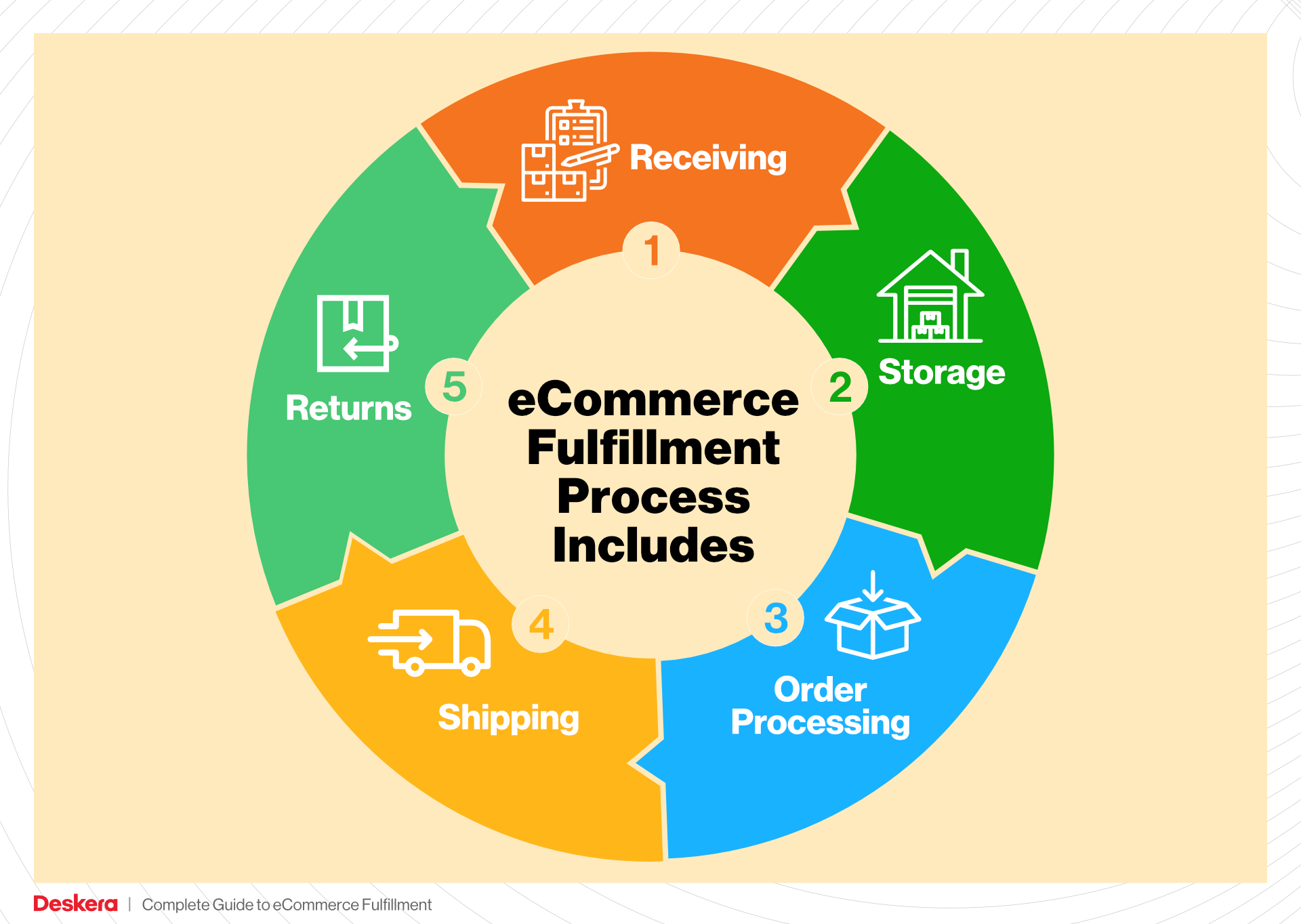
The goal of this guide is to empower you, the business owner or operations manager, to make smart, strategic decisions regarding your logistics and fulfillment processes. By the end of this journey, you will be equipped with the knowledge to streamline your operations, allowing you to focus on what you do best: growing your business.
What You’ll Learn In This Guide
- What is E-commerce Fulfillment? An Introduction for Growing Businesses
- The Order Fulfillment Process: From ‘Buy’ Button to Customer’s Door
- Comparing Fulfillment Models: In-House vs. 3PL vs. Dropshipping
- A Deep Dive into Amazon FBA: Pros, Cons, and Who It’s For
- Core Services Offered by Fulfillment Centers
- How to Choose a Fulfillment Partner: A 6-Point Checklist
- Understanding Fulfillment Pricing: A Breakdown of Common Fees
- Frequently Asked Questions (FAQs) about Fulfillment
- Conclusion: Is Outsourcing Fulfillment the Right Move for Your Business?
- Important Disclaimer
The Order Fulfillment Process: From ‘Buy’ Button to Customer’s Door
1. Receiving Inventory
The order fulfillment process begins with receiving inventory, which is a critical step in ensuring that the supply chain runs smoothly. When products arrive at the warehouse, they need to be carefully inspected for quality and quantity against the purchase order. This step often involves the use of Stock Keeping Units (SKUs), unique identifiers assigned to each product, which help streamline tracking and management.
Proper inventory receiving is important because it lays the foundation for efficient operations. Any discrepancies in quantity or quality can lead to stockouts or excess inventory, affecting customer satisfaction and operational costs. By implementing a robust receiving process, businesses can ensure that they have accurate stock levels, minimize returns, and maintain a reliable supply chain.
2. Warehouse Storage
Once the inventory has been received and verified, the next step is warehouse storage. This involves organizing products in a way that maximizes space and accessibility. Different storage methods, such as pallet racking, shelving, or bin systems, can be employed based on the type of products and the volume of inventory.
Efficient warehouse storage is vital because it directly impacts the speed and accuracy of order fulfillment. By utilizing a well-designed Warehouse Management System (WMS), businesses can track inventory locations, manage stock levels, and optimize space usage. A well-organized warehouse reduces the time it takes to locate items, thereby enhancing operational efficiency and reducing labor costs.
3. Order Picking
Order picking is the process of retrieving items from the warehouse to fulfill customer orders. This step is often guided by pick lists, which detail the items and quantities needed for each order. There are several picking methods, including single order picking, batch picking, and zone picking, each suited to different operational needs.
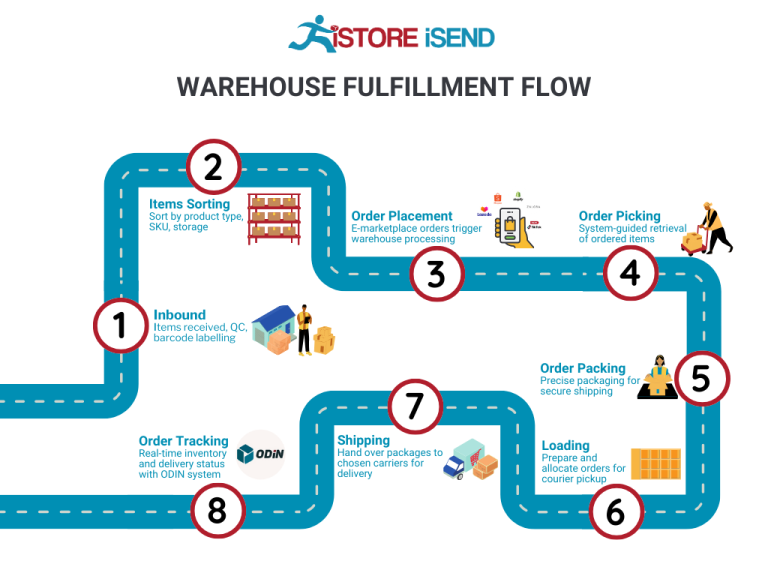
The importance of order picking cannot be overstated; it directly affects order accuracy and fulfillment speed. Errors during this stage can lead to incorrect shipments, resulting in customer dissatisfaction and increased return rates. By implementing technology such as barcode scanners or mobile picking solutions, businesses can enhance picking accuracy and efficiency, leading to a more streamlined fulfillment process.
4. Order Packing
After items have been picked, they must be packed securely for shipment. This step involves selecting appropriate packing materials, such as boxes, bubble wrap, or packing peanuts, and ensuring that products are protected during transit. The packing process often includes generating packing slips and labels, which contain critical information for both the customer and the shipping carrier.
Order packing is crucial for maintaining product integrity and ensuring a positive customer experience. Well-packed orders reduce the risk of damage during shipping and can enhance the perception of your brand. Moreover, efficient packing processes can lead to cost savings on shipping materials and reduced shipping costs, as properly sized packages are less expensive to send.
5. Shipping & Delivery
The final step in the order fulfillment process is shipping and delivery, where packed orders are handed over to a shipping carrier for delivery to the customer. This stage involves selecting the best shipping method based on factors such as cost, delivery speed, and destination. Businesses often work with multiple carriers and utilize transportation management systems (TMS) to optimize shipping routes and costs.
Shipping and delivery are critical components of customer satisfaction. Timely deliveries can significantly enhance the customer experience, while delays can lead to dissatisfaction and lost sales. By leveraging real-time tracking systems and providing customers with shipping updates, businesses can improve transparency and trust. A reliable shipping process not only ensures that customers receive their orders on time but also strengthens brand loyalty and encourages repeat purchases.
In conclusion, mastering the order fulfillment process is essential for any e-commerce business aiming to scale effectively. Each step—from receiving inventory to shipping and delivery—plays a vital role in the overall customer experience and operational efficiency. By focusing on these key areas, businesses can improve their logistics capabilities and drive growth in a competitive market.
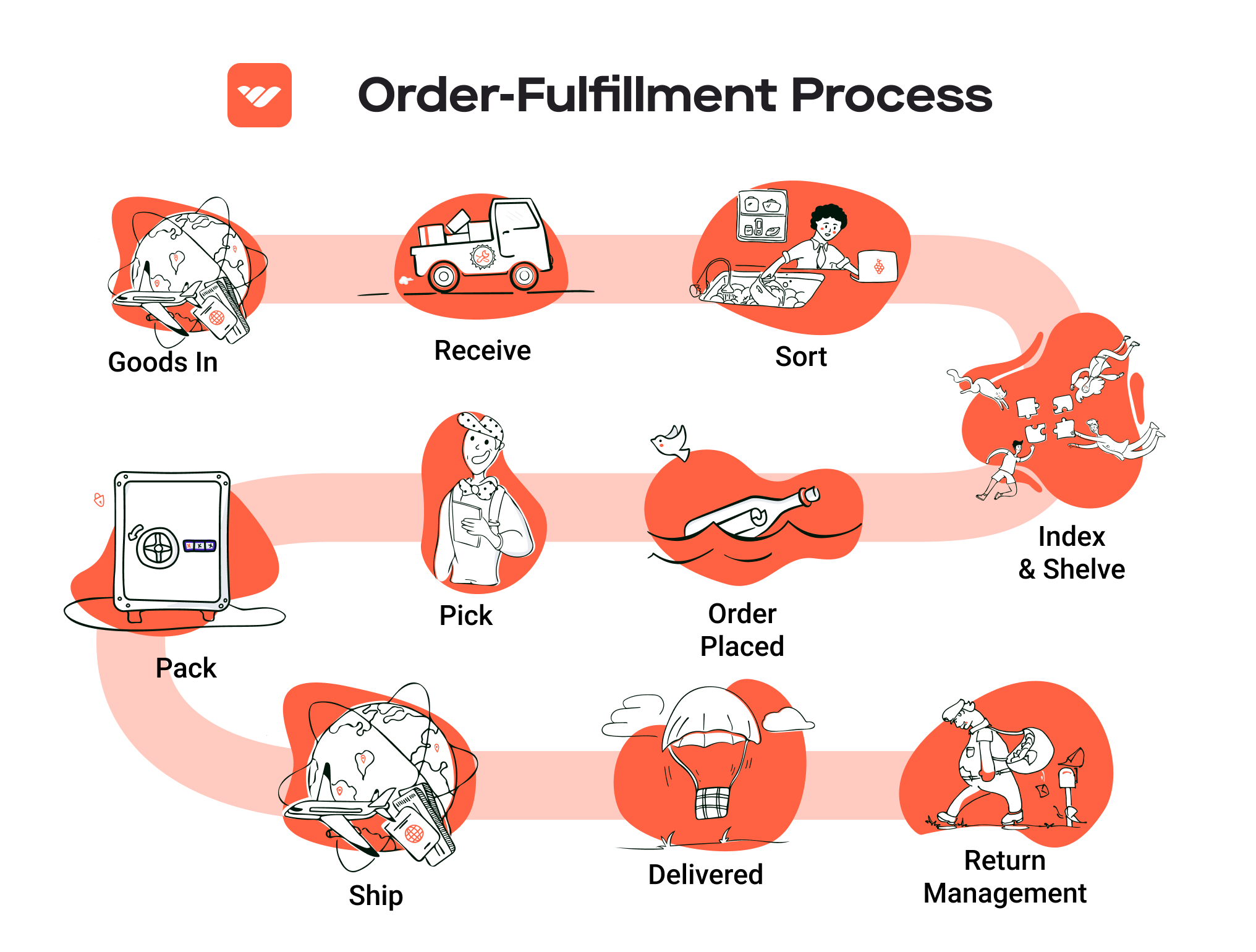
Comparing Fulfillment Models: In-House vs. 3PL vs. Dropshipping
Fulfillment Model Comparison
| Model | Who Handles Inventory | Best For (Business Stage) | Key Advantage | Key Disadvantage |
|---|---|---|---|---|
| In-House Fulfillment | The business itself | Established businesses with stable sales | Full control over inventory and processes | High overhead costs and resource allocation |
| Third-Party Logistics (3PL) | An external logistics provider | Growing businesses seeking scalability | Flexibility and access to expertise | Less control over operations and potential hidden costs |
| Dropshipping | The supplier | Startups or businesses with low capital | Low upfront investment and risk | Lower profit margins and reliance on supplier reliability |
In-House Fulfillment
In-house fulfillment refers to managing all aspects of storage, inventory management, order processing, and shipping within a company’s own facilities. This model is typically best suited for established businesses with stable sales volumes, as it allows for complete control over inventory and fulfillment processes. Companies that choose in-house fulfillment can customize their operations to meet their unique needs, ensuring that they maintain a high level of service quality. This model often appeals to businesses that have specific branding requirements or product handling needs. However, in-house fulfillment can lead to high overhead costs due to the need for warehouse space, staffing, and equipment. It also requires a significant investment in technology and systems to manage inventory and orders effectively, which can stretch resources, particularly for smaller businesses.
Third-Party Logistics (3PL)
Third-party logistics (3PL) involves partnering with an external logistics provider to handle various aspects of fulfillment, including warehousing, inventory management, and shipping. This model is ideal for growing businesses that need to scale their operations quickly without the burden of managing logistics in-house. By utilizing a 3PL, businesses gain access to specialized expertise, advanced technology, and established shipping networks, allowing them to focus on core activities like marketing and product development. The flexibility of 3PL services enables businesses to adapt to changing market demands more efficiently. However, one of the key disadvantages of using a 3PL is the potential loss of control over logistics operations. Additionally, businesses may face hidden costs related to service agreements, which can impact profit margins if not carefully managed. Successful partnerships with 3PL providers require clear communication and alignment on service expectations.
Dropshipping
Dropshipping is a fulfillment model where the retailer does not hold inventory but instead relies on suppliers to ship products directly to customers. This model is particularly attractive for startups or businesses with limited capital, as it eliminates the need for upfront inventory investment and reduces the risk associated with unsold stock. Entrepreneurs can focus on marketing and sales without the logistical complexities of managing inventory. However, dropshipping comes with significant drawbacks, including lower profit margins due to reliance on supplier pricing and the potential for order fulfillment issues if suppliers do not meet quality or delivery standards. Additionally, businesses may find it challenging to establish a strong brand identity, as they have limited control over product quality and shipping processes. Successful dropshipping requires careful supplier selection and a strong focus on customer service to mitigate the risks associated with this model.
Conclusion
Each fulfillment model—In-House Fulfillment, Third-Party Logistics (3PL), and Dropshipping—offers unique advantages and challenges that can significantly impact an e-commerce business’s growth and operational efficiency. Understanding these models allows business owners and operations managers to make informed decisions that align with their current business stage, resources, and long-term goals. As businesses evolve, they may find themselves transitioning between these models to adapt to changing market conditions, customer expectations, and operational capabilities.
A Deep Dive into Amazon FBA: Pros, Cons, and Who It’s For
Understanding Fulfillment by Amazon (FBA)
Fulfillment by Amazon (FBA) is a service provided by Amazon that allows sellers to store their products in Amazon’s fulfillment centers. Amazon then takes care of storage, packaging, shipping, and customer service on behalf of the seller. This service leverages Amazon’s vast logistics network, ensuring that products reach customers swiftly and efficiently.
When a customer orders a product, Amazon handles the entire fulfillment process, including picking, packing, and shipping the item directly to the customer. Sellers benefit from Amazon’s infrastructure, enabling them to reach millions of customers worldwide while saving time on logistics and order management.
How FBA Works
-
Setting Up an Account: To use FBA, sellers must first create an Amazon Seller account and enroll in the FBA program.
-
Listing Products: Sellers list their products on Amazon and select FBA as their fulfillment method. They can either create new listings or convert existing listings to FBA.
-
Shipping Inventory: Sellers ship their products to Amazon’s fulfillment centers. Amazon provides guidelines on how to prepare and package the products to ensure they are ready for storage and shipping.
-
Storage and Management: Once the products arrive at Amazon’s warehouse, they are stored until sold. Amazon manages the inventory, providing sellers with real-time tracking and inventory management tools.
-
Order Fulfillment: When a customer places an order, Amazon picks, packs, and ships the product on behalf of the seller. The seller benefits from Amazon’s expedited shipping options, including Prime delivery.
-
Customer Service: Amazon handles all customer inquiries and returns, providing a seamless experience for both sellers and customers.
Pros of Using Amazon FBA
1. Prime Eligibility
One of the most significant advantages of FBA is that products become eligible for Amazon Prime. This feature can dramatically increase sales, as Prime members often prefer products with fast, free shipping.
2. Customer Trust
Amazon is a trusted platform with a reputation for reliable service. By using FBA, sellers can leverage this trust, resulting in higher conversion rates. Products fulfilled by Amazon are often perceived as more credible and reliable.
3. Multi-Channel Fulfillment
FBA supports multi-channel fulfillment, allowing sellers to fulfill orders from other platforms (like Shopify or eBay) through Amazon’s logistics network. This flexibility can streamline operations and reduce shipping costs.
4. Time Savings
FBA allows sellers to focus on growing their business rather than managing logistics. Amazon handles storage, packing, shipping, and customer service, freeing up valuable time for sellers to invest in marketing and product development.
5. Scalability
FBA is designed to scale with your business. Whether you’re selling a few products or thousands, Amazon’s infrastructure can accommodate growth without the need for significant upfront investment in logistics.
Cons of Using Amazon FBA
1. High Fees
FBA comes with various fees, including storage fees for inventory and fulfillment fees per item sold. These costs can add up, especially for sellers with low-margin products, potentially eating into profits.
2. Strict Inventory Rules
Amazon has strict guidelines regarding inventory management. Sellers must adhere to regulations concerning storage limits, product preparation, and labeling. Failure to comply can result in penalties or removal of listings.
3. Commingling Risks
With FBA, products from different sellers are often stored together. This commingling can lead to issues if a seller’s product is damaged or if there are quality control problems, as the seller may receive negative feedback for issues that are out of their control.
4. Limited Control Over Branding
While FBA provides logistics advantages, it can limit a seller’s control over branding and packaging. Products are often shipped in generic Amazon packaging, which may not align with a seller’s branding strategy.
5. Dependency on Amazon
Utilizing FBA means relying on Amazon’s platform and policies. Any changes in Amazon’s rules, fees, or algorithms can significantly impact a seller’s business operations and profitability.
Who is FBA Best For?
FBA is particularly beneficial for:
-
Small to Medium-Sized Businesses: Sellers looking to expand their reach without the burden of managing logistics can greatly benefit from FBA. It allows them to focus on product development and marketing while Amazon handles fulfillment.
-
E-commerce Entrepreneurs: New sellers who want to leverage Amazon’s vast customer base and trust can quickly establish their presence using FBA.
-
Businesses with Seasonal Demand: Companies that experience fluctuations in demand can take advantage of Amazon’s infrastructure without the need for extensive warehousing.
-
Sellers with High-Volume Sales: Those who can maintain a steady sales volume can offset the high fees associated with FBA, benefiting from increased sales velocity and Prime eligibility.
In conclusion, while FBA offers significant advantages such as Prime eligibility and time savings, it also comes with its challenges, including high fees and strict inventory management rules. Sellers should carefully evaluate their business model and consider whether the benefits align with their operational capabilities and growth objectives.
Core Services Offered by Fulfillment Centers
Inventory Management & Warehousing
Inventory management and warehousing are foundational services provided by fulfillment centers. This involves the systematic control of inventory levels, storage, and the movement of goods within a warehouse. Fulfillment centers utilize advanced Warehouse Management Systems (WMS) that offer real-time visibility into inventory status, allowing businesses to track stock levels, manage reorders, and optimize space usage effectively.
Benefits:
– Accuracy and Efficiency: By leveraging technology, fulfillment centers can significantly reduce errors associated with manual inventory tracking. This leads to improved order accuracy, minimizing the risk of stockouts or overstock situations.
– Scalability: As e-commerce businesses grow, so too do their inventory needs. Fulfillment centers provide scalable solutions that can adapt to increasing inventory volumes without the need for substantial investments in additional warehouse space or staffing.
– Cost-Effectiveness: Outsourcing warehousing to a fulfillment center can be more economical than maintaining an in-house facility. Businesses save on overhead costs related to rent, utilities, and staffing while benefiting from the center’s operational expertise.
Pick and Pack Services
Pick and pack services involve the selection of items from inventory (picking) and the preparation of these items for shipment (packing). Fulfillment centers specialize in efficiently processing orders to ensure that items are accurately picked and securely packed for delivery.
Benefits:
– Speed: Fulfillment centers often have streamlined processes that allow for quick order processing, frequently shipping orders within 24 hours. This rapid turnaround is essential for e-commerce businesses that rely on prompt delivery to enhance customer satisfaction.
– Quality Control: Many fulfillment centers implement quality checks during the pick and pack process, ensuring that the correct items are selected and that they are in good condition before shipping. This reduces the likelihood of returns and enhances customer trust.
– Flexibility: Fulfillment centers can handle a wide variety of order sizes and types, from single-item orders to bulk shipments. This adaptability allows businesses to cater to diverse customer needs without compromising on service quality.
Kitting and Assembly
Kitting and assembly services involve the grouping of individual items into a single packaged unit or the assembly of products that require multiple components. This service is particularly useful for businesses that sell products that require bundling or assembly before they can be sold.
Benefits:
– Enhanced Product Offering: Kitting allows businesses to create unique product bundles that can attract customers and increase average order value. For example, a company might bundle a camera with accessories like lenses, bags, and tripods, offering a complete solution.
– Streamlined Operations: By outsourcing kitting and assembly to fulfillment centers, businesses can focus on their core competencies, such as marketing and product development. This division of labor can lead to improved operational efficiency.
– Inventory Management: Kitting services help in managing inventory more effectively by reducing the number of individual SKUs (Stock Keeping Units) that need to be tracked. This simplification can lead to cost savings and easier inventory control.
Returns Management (Reverse Logistics)
Returns management, also known as reverse logistics, is the process of handling product returns from customers. Fulfillment centers often offer comprehensive returns management services that include receiving returned items, inspecting them, restocking inventory, and processing refunds or exchanges.
Benefits:
– Customer Satisfaction: An efficient returns process is crucial for maintaining customer satisfaction and loyalty. Fulfillment centers can streamline this process, ensuring that returns are handled quickly and efficiently, which can positively impact customer perceptions of a brand.
– Data Insights: Returns management provides valuable insights into customer behavior and product performance. By analyzing return reasons, businesses can identify trends and make informed decisions about product offerings, quality improvements, and inventory management.
– Cost Efficiency: Managing returns in-house can be labor-intensive and costly. By outsourcing this function to a fulfillment center, businesses can reduce operational burdens and focus on growth while ensuring that returns are processed in a cost-effective manner.
Conclusion
In conclusion, the core services offered by fulfillment centers—inventory management and warehousing, pick and pack services, kitting and assembly, and returns management—are essential for e-commerce businesses looking to scale efficiently. By leveraging these services, businesses can improve operational efficiency, enhance customer satisfaction, and ultimately drive growth in a competitive market. Embracing fulfillment center partnerships allows e-commerce owners to focus on what they do best while entrusting logistics and fulfillment to experts in the field.
How to Choose a Fulfillment Partner: A 6-Point Checklist
Location & Warehouse Network
Why It’s Important:
The geographic location of your fulfillment partner’s warehouses can significantly impact shipping times and costs. A partner with strategically placed warehouses near your customer base can enhance delivery speed and reduce shipping expenses.
Questions to Ask:
– Where are your warehouses located, and how does that align with my target market?
– Do you have multiple warehouse locations? If so, how do you manage inventory across them?
– What shipping carriers do you partner with, and what are the average shipping times to key areas?
Technology & Integrations
Why It’s Important:
In today’s fast-paced e-commerce environment, robust technology solutions are essential for efficient order processing, inventory management, and real-time tracking. A fulfillment partner with advanced technology can streamline operations and provide transparency throughout the supply chain.
Questions to Ask:
– What warehouse management system (WMS) do you use, and what features does it offer?
– Can your technology integrate with my existing e-commerce platforms (e.g., Shopify, Amazon, Magento)?
– How do you handle order tracking and reporting? Can I access real-time data on my inventory and shipments?
Specializations (e.g., Cold Storage, Oversized Items)
Why It’s Important:
Different businesses have unique fulfillment needs, such as handling perishable goods, oversized items, or specialized packaging requirements. Choosing a partner that specializes in your specific needs can ensure that your products are handled properly and meet all regulatory requirements.
Questions to Ask:
– Do you have experience handling my type of product (e.g., perishable goods, fragile items)?
– What specialized services do you offer (e.g., cold storage, kitting, returns processing)?
– How do you ensure compliance with safety and quality standards for specialized items?
Scalability & Capacity
Why It’s Important:
As your business grows, your fulfillment needs will evolve. A partner that can scale operations in line with your growth is critical to maintaining service levels without disruption. Understanding their capacity and flexibility can help you avoid future bottlenecks.
Questions to Ask:
– What is your current capacity for handling orders, and how scalable is your operation?
– How do you manage peak seasons or unexpected surges in demand?
– What are your policies for increasing storage and labor during busy periods?
Pricing and Contracts
Why It’s Important:
Understanding the pricing structure and contract terms is crucial for budgeting and financial planning. Transparent pricing can help you avoid hidden fees and ensure that you are getting value for your investment.
Questions to Ask:
– Can you provide a detailed breakdown of your pricing model (e.g., storage fees, pick and pack fees, shipping costs)?
– Are there any additional fees I should be aware of (e.g., for returns, special handling)?
– What are the terms of your contract? Is there flexibility for renegotiation as our partnership evolves?
Customer Support & Reviews
Why It’s Important:
Reliable customer support can make a significant difference in your experience with a fulfillment partner. A responsive and knowledgeable support team can help resolve issues quickly, minimizing disruptions to your business. Additionally, reviewing feedback from other clients can provide insights into the partner’s performance and reliability.
Questions to Ask:
– What kind of customer support do you offer (e.g., dedicated account manager, 24/7 support)?
– Can you provide references or case studies from similar businesses you’ve worked with?
– How do you handle disputes or issues that may arise during the fulfillment process?
Conclusion
Choosing the right fulfillment partner is a critical decision that can influence your e-commerce business’s success. By carefully considering the factors outlined in this checklist, you can make an informed choice that aligns with your operational needs and growth objectives. Ensure you engage in thorough discussions with potential partners, asking the right questions to gauge their capabilities and fit for your business.
Understanding Fulfillment Pricing: A Breakdown of Common Fees
Initial Setup Fees
Initial setup fees are often the first costs incurred when partnering with a fulfillment provider. These fees cover the administrative and operational costs associated with onboarding your business, including system integration, inventory setup, and training.
Typically, initial setup fees can range from a few hundred to several thousand dollars, depending on the complexity of your operations and the level of customization required. For instance, if your business needs a tailored warehouse management system (WMS) to integrate with your e-commerce platform, expect higher fees. These fees are usually a one-time charge, but it’s essential to clarify what is included to avoid unexpected costs.
Receiving Fees
Receiving fees are charged when your products arrive at the fulfillment center. This fee covers the labor and resources needed to unload, inspect, and inventory your goods.
Receiving fees can vary based on several factors, including the volume and type of products you send. For example, larger shipments may incur lower per-unit receiving fees due to economies of scale, while small, irregularly shaped items may have higher fees. Some providers may charge a flat rate per shipment, while others may calculate fees based on the total weight or number of pallets. Understanding this fee structure is crucial for budgeting your logistics expenses accurately.
Storage Fees (per pallet/bin)
Storage fees are recurring charges for the space your products occupy within the warehouse. These fees can be calculated per pallet, bin, or square footage, depending on the provider’s pricing model.
Typically, storage fees are assessed on a monthly basis. For example, a common rate might be $10 to $25 per pallet per month, but this can vary based on geographic location, facility type, and demand for warehouse space. Additionally, some providers offer tiered pricing; the more pallets you store, the lower the per-pallet cost. It’s essential to monitor your inventory levels and turnover rates to avoid incurring unnecessary storage fees for slow-moving products.
Pick & Pack Fees (per item/order)
Pick and pack fees are charged for the labor involved in retrieving items from storage and preparing them for shipment. This fee can be calculated on a per-item or per-order basis, depending on the fulfillment center’s policy.
For instance, a typical pick fee might range from $0.50 to $2.00 per item, while packing fees may vary based on the complexity of the order. More complicated orders, such as those requiring special packaging or kitting, may incur additional charges. Understanding the specifics of these fees is crucial for forecasting fulfillment costs accurately, especially if your business experiences seasonal fluctuations in order volume.
Shipping Fees
Shipping fees encompass the costs of transporting your products from the fulfillment center to your customers. These fees can vary significantly based on factors such as shipping method, weight, dimensions, distance, and carrier rates.
Providers often negotiate shipping rates with carriers, which can lead to varying costs based on the service level (standard, expedited, or overnight). Additionally, some fulfillment centers may offer flat-rate shipping options for specific packages or regions, making it easier to predict costs. It’s advisable to review your shipping strategy regularly to ensure you’re utilizing the most cost-effective options available.
Tips for Getting an Accurate Quote
-
Detail Your Needs: When requesting a quote, be as specific as possible about your products, order volumes, and service expectations. This clarity helps providers give you a more accurate estimate.
-
Ask About Hidden Fees: Inquire about any additional costs not included in the initial quote, such as surcharges for special handling, returns processing, or seasonal storage increases.
-
Consider Long-Term Contracts: If you anticipate high volumes, consider negotiating long-term contracts, as fulfillment providers may offer discounted rates for committed business.
-
Request a Breakdown: Always ask for a detailed breakdown of all fees, including setup, receiving, storage, pick and pack, and shipping. This transparency will help you understand your total cost of fulfillment.
-
Compare Multiple Providers: Don’t settle on the first quote you receive. Comparing multiple fulfillment providers will give you a better understanding of the market rates and help you find the best fit for your business needs.
By carefully evaluating these common fulfillment fees and following these tips, you can make informed decisions that support the growth and scalability of your e-commerce business.
Frequently Asked Questions (FAQs) about Fulfillment
1. What is elite logistics & fulfillment?
Elite logistics & fulfillment refers to a comprehensive suite of services that streamline the supply chain process for businesses, particularly in e-commerce. It encompasses warehousing, order fulfillment, distribution, inventory management, and transportation services, all aimed at delivering products efficiently and accurately to customers.
2. What is the difference between a warehouse and a fulfillment center?
A warehouse is primarily a storage facility where goods are kept until they are needed. In contrast, a fulfillment center is a specialized type of warehouse that focuses on processing and shipping customer orders. Fulfillment centers are equipped with systems and technologies that manage inventory levels, process orders, and ensure timely delivery, playing a crucial role in e-commerce operations.
3. What is a 3PL?
A 3PL, or third-party logistics provider, is a company that offers outsourced logistics services, including warehousing, fulfillment, and transportation. Businesses often partner with a 3PL to leverage their expertise, technology, and networks, allowing them to focus on core operations while ensuring efficient order processing and delivery.
4. How much do fulfillment services cost?
The cost of fulfillment services varies based on several factors, including order volume, the complexity of services required, storage space needed, and shipping destinations. Typically, businesses can expect to pay a combination of fixed fees (for storage and handling) and variable fees (based on order volume and shipping costs). It’s advisable to obtain quotes from multiple providers to assess the most cost-effective solution for your business.
5. How can I improve my order fulfillment process?
Improving your order fulfillment process can be achieved by investing in technology (like a robust Warehouse Management System), optimizing inventory management, streamlining shipping processes, and establishing clear communication with your fulfillment partner. Regularly reviewing and analyzing performance metrics can also help identify areas for improvement.
6. What is the importance of real-time inventory tracking?
Real-time inventory tracking is critical for maintaining accurate stock levels, reducing overstock and stockouts, and improving order accuracy. With real-time visibility into inventory, businesses can make informed decisions about restocking, fulfill orders efficiently, and enhance customer satisfaction by ensuring timely delivery.
7. What services are typically included in fulfillment solutions?
Fulfillment solutions often include warehousing, inventory management, order processing, pick and pack services, returns management, shipping and logistics, and customer support. Some providers also offer specialized services like kitting, multi-packaging, and integrated web commerce solutions.
8. How do I choose the right fulfillment partner?
Choosing the right fulfillment partner involves assessing your specific needs, evaluating the provider’s capabilities, reviewing their technology and systems, and considering their experience in your industry. It’s also important to check customer reviews and testimonials, as well as their responsiveness and customer service quality.
9. What are the benefits of using a fulfillment service?
Utilizing a fulfillment service can lead to several benefits, including reduced operational costs, increased efficiency, scalability as your business grows, improved customer satisfaction due to faster shipping, and access to advanced technologies and expertise that you may not have in-house.
10. How can I handle returns efficiently?
To handle returns efficiently, establish a clear returns policy, use an integrated system that manages returns alongside your fulfillment operations, and automate as many processes as possible. Providing customers with easy-to-follow return instructions and maintaining open communication can also enhance the returns experience, ultimately leading to improved customer loyalty.
Conclusion: Is Outsourcing Fulfillment the Right Move for Your Business?
Evaluating the Benefits of Outsourcing Fulfillment
In today’s competitive e-commerce landscape, outsourcing fulfillment can provide significant advantages for your business. By partnering with a specialized fulfillment service, you can save valuable time and resources that would otherwise be spent managing logistics. This allows you to focus on core business activities, such as product development and marketing, rather than getting bogged down in operational details.
One of the most compelling benefits of outsourcing fulfillment is scalability. As your business grows, so do your logistical needs. A proficient fulfillment partner can effortlessly adjust to increased order volumes, seasonal demands, and the complexities of global shipping. This flexibility not only supports your growth but also enhances your ability to respond quickly to market changes without the burden of investing in additional infrastructure.
Additionally, fulfillment providers bring a wealth of expertise and industry knowledge. They have established systems, technologies, and best practices that can streamline your supply chain processes. This level of professionalism often results in improved accuracy in order processing and inventory management, ultimately leading to higher customer satisfaction rates.
However, the key to reaping these benefits lies in choosing the right fulfillment partner. A misaligned partnership can lead to inefficiencies and dissatisfaction. Look for providers with a proven track record, robust technology solutions, and a commitment to transparency and accountability.
Take Action
As you consider whether outsourcing fulfillment is the right move for your business, take the time to audit your current shipping processes. Evaluate areas where you may be losing time or resources and assess how a fulfillment partner could enhance your operations. By making informed decisions now, you can position your business for sustainable growth and success in the future.
Important Disclaimer
⚠️ Important Disclaimer
The information in this guide is for educational purposes. Fulfillment services, pricing, and platform features change frequently. Always conduct your own due diligence and consult with providers directly before making business decisions.
